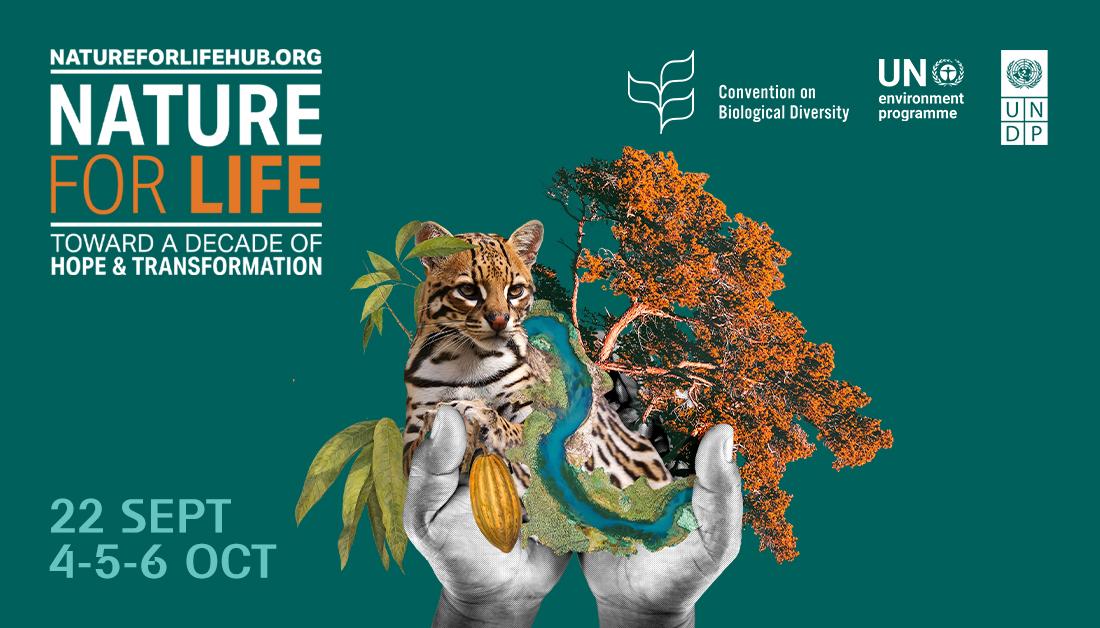Nature can sometimes be the poor cousin to climate change. There are few people around the world unable to articulate at least some causes and impacts of our climate crisis, but if you were to ask the same about our biodiversity crisis, you would largely be met with blank stares. Unlike climate change, the scope of our nature crisis is largely invisible, has no simple set of causes, and has no simple target – there is no 1.5 C equivalent for biodiversity. The lack of understanding of the intertwined climate and nature crises, and their profound impact on humanity, is itself a crisis.
Two years ago, we set out to make some noise about this dual crisis. We set up shop two blocks from Grand Central Terminal in New York City and held a four-day event called “The Nature’s Climate Hub,” attracting more than 3,000 people. Last year we pivoted to an entirely virtual event, with the Nature for Life Hub. Featuring 40 Heads of State, 30 corporations, 15 Indigenous peoples leaders and scores of organizations – 300 partners in all, the Hub was watched by more than 150,000 people last year, and the hashtag #NatureForLife reached more than 150 million people.
We’re at it again. This year’s Nature for Life Hub, with a theme of “Responding to our Planetary Crises: Toward a Decade of Hope and Transformation,” kicks off on September 22nd with a two hour high-level event on Transformative Action for Nature and People . The Hub continues on October 4th: Transforming our Relationship with the Planet; October 5th: Transforming Production, from the Ground Up and October 6th : Toward a Nature-Positive Future with more than 15 hours of content on how the world is responding to our nature and climate crisis, and will include launches, announcements, commitments and stories of hope and transformation on nature and people from global leaders hailing from a wide variety of sectors.
First the easy part – transformation. To define the transformations needed in this decade to avert an extinction crisis requires first, understanding of the extent of the crisis itself. If your daily social news feed is as calibrated toward biodiversity loss as our is, there is a torrent of information available, largely fuelled by environmental and science divisions of The Guardian, the New York Times, Mongabay, the World Economic Forum, the Financial Times, and a few other outlets that specialize in this field. Doomscrolling through this rarefied news feed, the scope of the crisis is clear: we are fast approaching irreversible tipping points in nature that will imperil humanity and lead to widespread extinctions; our food systems are wreaking havoc on the planet and exacerbating inequality; and our financial, market and development models are broken and require profound retooling.
This crisis then defines the transformations that we must see in this decade: radically increase ambition on the protection and restoration of ecosystems, including through respecting the rights of Indigenous peoples, who manage a third of the Earth’s lands; shifting to community-centred, climate-resilient regenerative food systems; putting nature at the heart of development planning; and retooling our market and financial systems to account for nature’s services.
Now the hard part – hope. Daily doomscrolling of articles about the collapse of the planet can take a toll. But amid all of the doom, there are many, many bright spots of hope and actual transformation. From the more than 20 heads of state and half dozen philanthropies who will be making renewed commitments in the Hub’s opening session as part of the High Ambition Coalition, the Leaders Pledge for Nature and the Global Ocean Alliance, to this year’s inspiring Equator Prize winners who showcase local action on nature-based solutions, and from the Taskforce on Nature-Related Financial Disclosures, to governments developing their own “Maps of Hope,” we found that the world is not only waking up to the nature crisis, but is swiftly taking action to avert this crisis. This is indeed cause for hope and celebration. In total, we are curating more than 500 short videos that not only feature the transformations we need, but showcase the transformative actions that governments, businesses, communities and civil society are already taking.
Our job is to amplify these stories by widely sharing within our networks and on social media. The Nature for Life Hub is free and open to all, available in English, Spanish and French. The contents will be available long after the Hub is over, in bite-sized social media-ready short videos, ready for watching and sharing, and for catalysing transformation and spreading hope. We invite you to join us and find your own reasons for hope.

 Locations
Locations